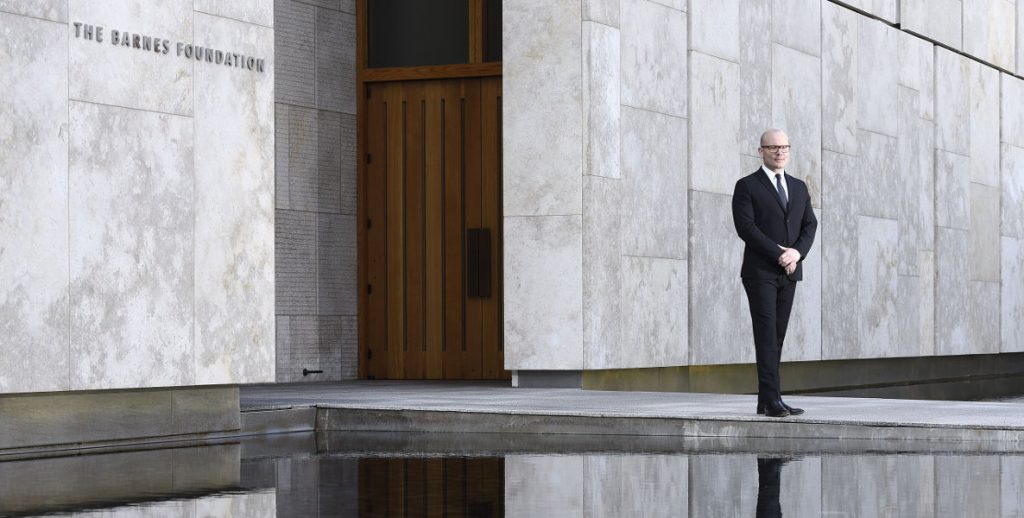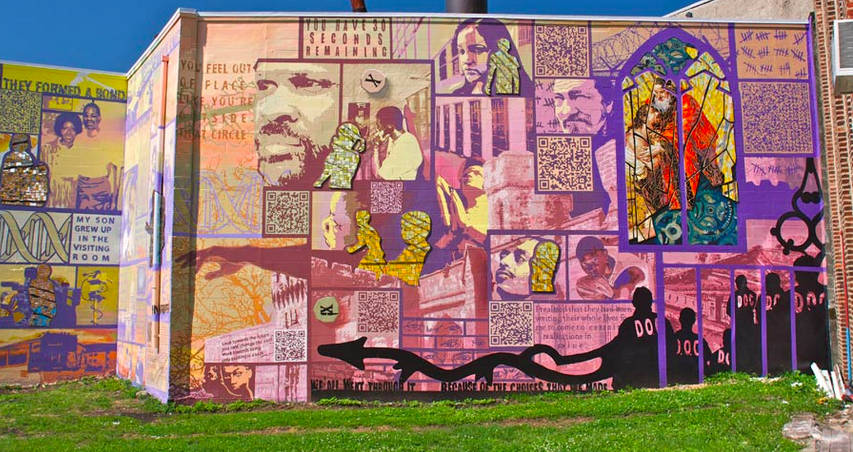It’s striking how much The Barnes Foundation’s “Person of the Crowd” exhibit mirrors the current spirit of street protest and social activism. Just a month before the show opened in February, thousands of Philadelphians joined the Women’s March, passing in front of The Barnes to protest the country’s new president and his policies. As the protest broke up and people dispersed, marchers wedged homemade signs and placards into the Vine Street Expressway fencing overpass. It was an impromptu, street-inspired art show. The signs—a variety of styles from sincere, to snarky, comical, clever, hasty, and provocative—were from people responding creatively to a time and place.
Yet, Thom Collins, the foundation’s dynamic executive director and president says this multimedia show—featuring 50 artists from around the world—is actually an expanded version of a show he did at the Neuberger Museum at SUNY Purchase in 2008.
“But, the fact that it seems uniquely relevant, is part of our strategy for social engagement,” says Collins, who came to The Barnes two years ago. “It clearly points to our commitment to extend Dr. Barnes’s institutional engagement with diversity, inclusion and social justice causes. A lot of the work in this show addresses those same kinds of issues, and various kinds of inequalities—economic, social, political.”
Wait, what? Wealthy Dr. Barnes was a champion of the have-nots and social justice? It didn’t square with the moneyed, imperious image I had of Barnes.
When you think of the late Dr. Albert Barnes, the collector of one of the world’s most celebrated private collections of Impressionist and Modernist art, you may recall him as a cartoonishly cantankerous character. He was a grudge-holding self-made man who didn’t fit into Philadelphia society. As a combative parvenu from working-class Kensington, he was forever exiled from the chummy ranks of the social elite.
On first pass walking through the exhibit space, the show seemed shockingly fresh, modern, loose, and bohemian. It was not at all what I’d expected from a once-fussy, tightly-wound institution. So, I was wrong.
Everyone acknowledges that Barnes had a shrewd eye for buying art. Its current value is estimated to be between $20 and $30 billion. (As an entrepreneur, he’d made his fortunes by developing an eye drop for newborns that would fatten his wallet and ensure years of obsessive art collecting.)
But, The Barnes Foundation was notorious for its prickly vibe. There were rigid rules about when the public could see the collection, which was intended primarily for its enrolled students. When you visited the Main Line site, you imagined a pained tolerance as you progressed through hallowed grounds without the proper Barnesian indoctrination. Arranged salon style in poorly lit rooms, the works were not labeled, so you were on your own to identify them.
The Barnes made headlines again when it moved in 2012 from the foundation’s home in Merion, Pa. to the Benjamin Franklin Parkway. The drama originated from the restrictive legal terms dictated by Barnes himself in his will that led to intractable money troubles. (Barnes died in a car accident in 1951 at age 79. True to his mulish nature, he was hit by a truck after running a stop sign in Phoenixville that he routinely ignored because he objected to its installation.) Despite Barnes’s best effort to keep his art out of the city and control his collection from beyond the grave, his commandments were overruled by the court and the new location opened five years ago in Center City. It has won positive reviews for its elegant and sensitive architectural design by Tod Williams and Billie Tsien.
So, Barnes’s difficult nature and his quirky institution, a bit stuck in the past—despite its chic, new quarters—was foremost in my mind on my recent visit to see “Person of the Crowd.” The exhibit has work in the gallery and also around the city. It includes video installations, found objects, maps, posters, billboards, and performance art. On first pass walking through the exhibit space, the show seemed shockingly fresh, modern, loose, and bohemian. It was not at all what I’d expected from a once-fussy, tightly-wound institution.
So, I was wrong.
“The strategy of the flaneur was the strategy that had been only available to privileged white men at that time in Paris, London, Berlin or New York,” says Collins about the original 19th-century practice of flanerie (those who leisurely strolled the city in unplanned ways to observe it). “But this show deliberately takes that strategy, which is so central to the power of Impressionist work, and explores what it means when that strategy is embraced and modified by artists of color, women and those who do not operate in a privileged situation.”

To further explore these issues, The Barnes is hosting an all-day symposium on Saturday called “Flanerie and the Politics of Public Space.” At the event, artists and scholars will discuss the history of flanerie, and the contemporary politics inherent in just walking down the street.
Collins, a Philly native, came to The Barnes two years ago after leading Miami’s Perez Art Museum in a much-heralded move to the waterfront. It was as a curator at Cincinnati’s Contemporary Arts Center where he first explored the notion of how visitors engage with, not just view, art—something he has made a mandate of sorts for his tenure at The Barnes. A populist in what is traditionally seen as an elitist’s field, Collins is on a mission to broaden the museum’s audience.
He gave me a history lesson about Dr. Barnes’s values of egalitarian art education and his commitment to social justice. Sure, the doctor had run his school with an abrasive, autocratic style and had enforced the strictly prescribed “Barnes method” for analyzing art work. That part I knew. But, his anti-elitist progressive mission to educate, with emphasis on including African-Americans and those on the outside of the white, bourgeois establishment, was somehow information I’d missed in all of the noise.
Collins explained to me that as a child, Barnes had grown up abjectly poor in Kensington. His mother had been a devout Methodist and taken him along to Methodist camp meetings and revivals which he loved. These were integrated gathering and the African-American music and song the young Barnes heard there deeply affected him and he described it as his “first aesthetic experience.”
Mary Ann Meyers wrote in her book, Albert Barnes and the Science of Philanthropy: Art, Education and African-American Culture, that it made a deep impression that influenced his whole life. This included Barnes’ drive and success in amassing a significant collection of African art that he showed alongside his European work.
Notably moving in different circles than Philadelphia society, Barnes surrounded himself with some of the most significant leaders of the Harlem Renaissance and the burgeoning Civil Rights movement including writer and philosopher Alain Locke, sociologist Charles Johnson, and later, the president of Lincoln University, Horace Mann Bond.
“Barnes’s commitment to what we would call early civil rights causes is pronounced,” says Collins. “He was really engaged and involved with the thinkers who were behind and who created the foundational philosophy and politics of the Harlem Renaissance.”
“Barnes’s commitment to what we would call early civil rights causes is pronounced,” says Collins. “He was really engaged and involved with the thinkers who were behind and who created the foundational philosophy and politics of the Harlem Renaissance.” Barnes hired African-Americans to work in his chemical factory when segregation was the norm and publicly denounced the practice.
This current exhibit, with its vibrant work—with quite a bit about political disenfranchisement of minority populations—derives its power from the dynamism and energy of the street and common people. These could be the same every day “plain people” Barnes wrote about in his institution’s bylaws that he was committed to serving. So this exhibit, as it turns out, has a very-Barnesian spirit.
The show is loaded with messy, democratic art-making. A lot of the work challenges outside forces to tangle with it. You’ll see video of Tania Bruguera’s 1998 performance work, “Displacement,” which was made to protest Fidel Castro’s broken social promises to his people. In it, she wore a ominous garment made of earth, cloth, wood and nails, that resembled a nkisi nkonde icon, a Congolese power figure and walked the streets of Havana. (She’ll don a similar costume for a performance in various locations around town on May 4.) You’ll see graffiti artist Keith Haring’s quickly drawn chalk piece, “Still Alive in 85,” on a saved subway ad space. A video loops of Zhang Huan’s performance piece made to commemorate the 9/11 terrorist attacks where he walks New York City in a muscular, raw meat suit, sewn by seamstresses from Chinatown. He embodies the traumatized city, stripped bare, flayed but still powerful. African-American artist Jefferson Pinder’s 2001 video work, “Marathon,” shows him running from a Baltimore park naked and acquiring more and more clothes as he runs along streets from the most blighted parts of the city before finally arriving, fully clothed as a businessman in the business district.
The work in the show is gritty and rough, and far from the framed elegance of a Cezanne or Degas, yet it possesses the same urge for fresh expression of a moment in time when the artist engages with the environment.
The exhibit’s sensibility probably would have agreed with Dr. Barnes, in spite of the pleasure he took in being a contrarian. “While much of the work is post-war and contemporary and involves new media that would have been unfamiliar to Dr. Barnes,” Collins asserts. “The work in the show employs flanerie as an engine for the issues that were near and dear to him.”
Person of the Crowd: The Contemporary Art of Flanerie, through May 22, Barnes Foundation, 2025 Benjamin Franklin Parkway, 215-278-7000, barnesfoundation.org; personofthecrowed.org
Header photo courtesy of The Barnes Foundation






